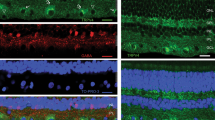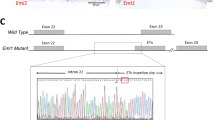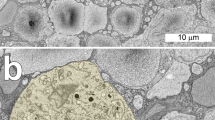Abstract
VERTEBRATE photoreceptors respond to illumination with a reduction in the steady current of Na ions which in darkness flows inwards across the outer segment membrane; this results in hyperpolarisation of the cells1. The light responses of the receptors can be studied by measuring extracellular voltage gradients2 or by intracellular recording1, but these methods can only provide information averaged over many photoreceptors owing respectively to high extracellular conductivity and to the presence of electrical coupling between cells3–;6. This averaging and the presence of dark voltage noise in photoreceptors6,7 have prevented observation of the electrical effects of individual photoisomerisations. To try to record these elementary events and to localise the source of the dark noise, we have developed a method for recording the membrane current of a single rod outer segment. The technique is based on that used by Neher and Sakmann8 on muscle fibres.
This is a preview of subscription content, access via your institution
Access options
Subscribe to this journal
Receive 51 print issues and online access
$199.00 per year
only $3.90 per issue
Buy this article
- Purchase on Springer Link
- Instant access to full article PDF
Prices may be subject to local taxes which are calculated during checkout
Similar content being viewed by others
References
Tomita, T. Q. Rev. Biophys. 3, 179–222 (1970).
Penn, R. D. & Hagins, W. A. Biophys. J. 12, 1073–1094 (1972).
Baylor, D. A. & Hodgkin, A. L. J. Physiol., Lond. 234, 163–198 (1973).
Fain, G. L., Gold, G. H. & Dowling, J. E. Cold Spring Harb. Symp. quant. Biol. 15, 547–561 (1976).
Schwartz, E. A. J. Physiol., Lond. 257, 379–406 (1976).
Lamb, T. D. & Simon, E. J. J. Physiol., Lond. 263, 257–286 (1976).
Schwartz, E. A. J. Physiol., Lond. (in the press).
Neher, E. & Sakmann, B. Nature 260, 799–802 (1976).
Brown, J. E. & Pinto, L. H. J. Physiol., Lond. 236, 575–591 (1974).
Baylor, D. A. & Fuortes, M. G. F. J. Physiol., Lond. 207, 77–92 (1970).
Katz, B. & Miledi, R. J. Physiol., Lond. 224, 665–699 (1972).
Anderson, C. R. & Stevens, C. F. J. Physiol., Lond. 235, 655–691 (1973).
Almers, W. & Levinson, S. R. J. Physiol., Lond. 247, 483–509 (1975).
Conti, F., Hille, B., Neumcke, B., Nonner, W. & Stampfli, R. J. Physiol., Lond. 262, 699–727 (1976).
Hladky, S. B. & Haydon, D. A. Nature 225, 451–453 (1970).
Jagger, W. S. Eur. J. Physiol. 362 (suppl.). R47 (1976).
Author information
Authors and Affiliations
Rights and permissions
About this article
Cite this article
YAU, KW., LAMB, T. & BAYLOR, D. Light-induced fluctuations in membrane current of single toad rod outer segments. Nature 269, 78–80 (1977). https://doi.org/10.1038/269078a0
Received:
Accepted:
Issue Date:
DOI: https://doi.org/10.1038/269078a0
This article is cited by
-
Gating and ion selectivity of Channelrhodopsins are critical for photo-activated orientation of Chlamydomonas as shown by in vivo point mutation
Nature Communications (2022)
-
Why rods and cones?
Eye (2016)
-
Olfactory signalling in vertebrates and insects: differences and commonalities
Nature Reviews Neuroscience (2010)
-
An Overview of Drug Development with Special Emphasis on the Role of Visual Electrophysiological Testing
Documenta Ophthalmologica (2005)
Comments
By submitting a comment you agree to abide by our Terms and Community Guidelines. If you find something abusive or that does not comply with our terms or guidelines please flag it as inappropriate.



